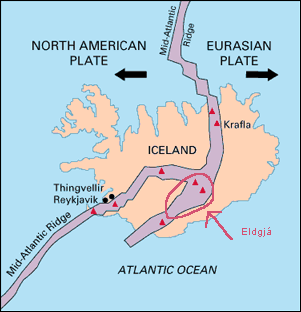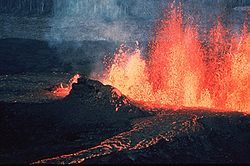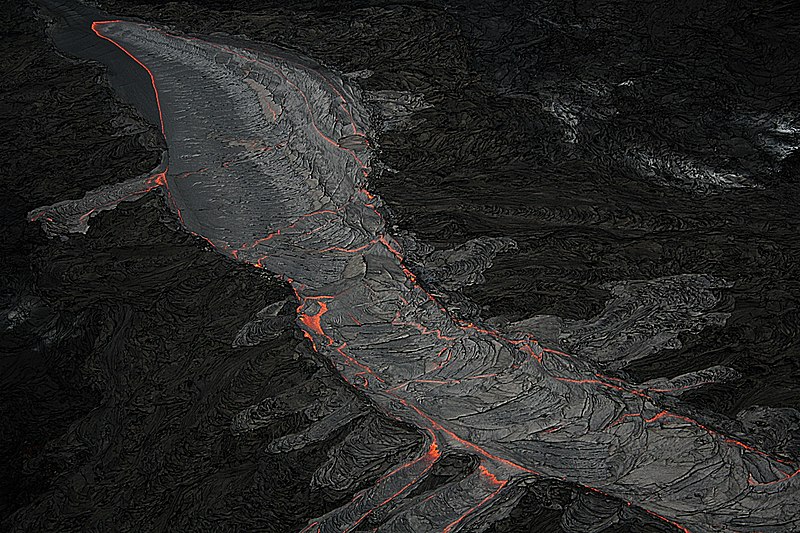Eldgjá fissure vulcano and the canyon.
 Iceland is splitting along the Mid-Atlantic Ridge - a divergent boundary between the North American and Eurasian Plates. As North America moves westward and Eurasia eastward there will be space in the crustal. Underneath this boundary is a lava hotspot. The movement of the plates gives space for the lava to come to the surface. The surface of Iceland is covered with ice. When the lava reached the surface it will melt and float through the fissure to the ocean and start the creation of the canyon. When the ice is melted, the lava will follow the same route to the sea. The Eldgjá fissure and canyon is the result of this plates movement .
Iceland is splitting along the Mid-Atlantic Ridge - a divergent boundary between the North American and Eurasian Plates. As North America moves westward and Eurasia eastward there will be space in the crustal. Underneath this boundary is a lava hotspot. The movement of the plates gives space for the lava to come to the surface. The surface of Iceland is covered with ice. When the lava reached the surface it will melt and float through the fissure to the ocean and start the creation of the canyon. When the ice is melted, the lava will follow the same route to the sea. The Eldgjá fissure and canyon is the result of this plates movement .
When you reach the parking place you can take a walk into the canyon. In the canyon you can experience the power of the float which created this canyon. Common know canyons are created by water flows and are sinuous. This canyon is created in a few weeks and is almost in a straight line. The reason for this is the hot lava which melted the earth on its way down. Imagine the power of the moving lava when you are in the canyon.
Another thing to notify is the bottom of the canyon. It is almost flat. In a canyon created by water you will never find a flat bottom on search a large scale. The flat bottom is the result of the solidified lava, which is in the canyon. During your walk you will find the unique caves which only exists in this type of lava floats. They are created at the last days of the eruption. The lava doesn't flow in the last day’s but is still hot enough to bubble the gasses which are coming out of the fissure underneath it. Note that it was a series of bubbles which created this type of caves. The bubble periods can hold on for a few weeks.
Eldgjá region.
Eldgjá and the Katla volcano are part of the same volcanic system in the south of the country. Eldgjá means "fire canyon" in Icelandic. Situated between Landmannalaugar and Kirkjubæjarklaustur, Eldgjá is the largest volcanic canyon in the world, 270m deep and 600m wide at its greatest. The first documented eruption in 934 was the largest flood basalt in historic time. The areal extent of the lava is around 800 km2. An estimated 18 km³ of magma poured out of the earth. There is a waterfall named Ófærufoss within the canyon. A natural bridge across the waterfall vanished in 1993 due to excess water from melting ice.

The Eldgjá fissure volcano is in fact a range of explosion volcano’s spread over a length of 30 kilometers. The canyon is much shorter. On the location is an information sign which tells you the length of the canyon.
Geology
A fissure vent, also known as a volcanic fissure or simply fissure, is a linear volcanic vent through which lava erupts, usually without any explosive activity. The vent is usually a few meters wide and may be many kilometers long. Fissure vents can cause large flood basalts and lava channels. This type of volcano is usually hard to recognize from the ground and from outer space because it has no central caldera and the surface is mostly flat. The volcano can usually be seen as a crack in the ground or on the ocean floor. Narrow fissures can be filled in with lava that hardens. As erosion removes its surroundings, the lava mass could stand above the surface as a dyke. The dykes that feed fissures reach the surface from depths of a few kilometers. Fissures are usually found in or along rifts and rift zones, such as Iceland and the East African Rift. Fissure vents are often found in shield volcanoes.
Volcanic vents are often long fissures parallel to the rift zone where lithospheric plates are diverging. Renewed eruptions generally occur from new parallel fractures offset by a few hundred to thousands of meters from the earlier fissures. This distribution of vents and voluminous eruptions of fluid basaltic lava usually build up a thick lava plateau rather than a single volcanic edifice. The Laki fissure system produced the biggest eruption on earth in historical times, in the form of a flood basalt, during the Eldgjá eruption A.D. 934, which released 19.6 km³ (4.7 mi³) of lava.
 This picture is taken in Hawaii. The radial fissure vents of the volcanoes produce “curtains of fire” as lava fountains erupt along a portion of a fissure. These vents produce low ramparts of basaltic spatter on both sides of the fissure. More isolated lava fountains along the fissure produce crater rows of small spatter and cinder cones. The fragments that form a spatter cone are hot and plastic enough to weld together, while the fragments that form a cinder cone remain separate because of their lower temperature.
This picture is taken in Hawaii. The radial fissure vents of the volcanoes produce “curtains of fire” as lava fountains erupt along a portion of a fissure. These vents produce low ramparts of basaltic spatter on both sides of the fissure. More isolated lava fountains along the fissure produce crater rows of small spatter and cinder cones. The fragments that form a spatter cone are hot and plastic enough to weld together, while the fragments that form a cinder cone remain separate because of their lower temperature.
 Lava channel with overflows.
Lava channel with overflows.
To log the cache you must mail me the answers of the questions below;
1) Near the parking place is a cave or hole in the ground. This type of caves/holes can only be found in fissure areas. This one is very wide and deep. Can you give an estimation of the broad and the depth of the cave/hole?
2) The definition for a cave and a hole differs. However both do not fit fully in this location. Which one fits the best, in your opinion, and explain your answer in a few lines.
3) As you can see has this cave a special shape. These form is astonishing, especially when you consider that it was formed when the lava was fluid. How do you think these cave was formed?
Provide me an estimation of the time required to develop this cave?
4) The edge of this cave is higher than the surrounding. Can you explain this?
5) In 1783-84 has taken one of the latest lava flows place in this area. What is the name of the flow in Icelandic?
Please send me your answers before logging the cache. Non confirmed logs will be deleted.
Off course you can upload a picture. However it is optionally.
I hope you enjoy this Earthcache! Have fun and please stay on the paths!
